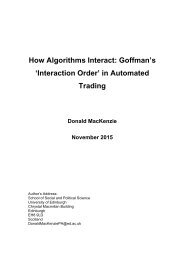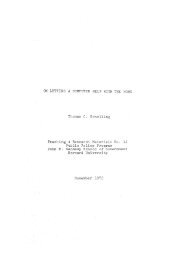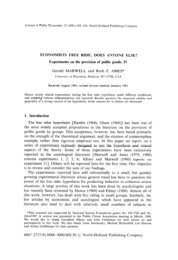n3-al-mukhatabat-journal
n3-al-mukhatabat-journal
n3-al-mukhatabat-journal
Create successful ePaper yourself
Turn your PDF publications into a flip-book with our unique Google optimized e-Paper software.
psychologic<strong>al</strong> archetypes. This relates to Kuhn’s controversi<strong>al</strong> view on<br />
‘incommensurability’ and his idea of ‘metaphysic<strong>al</strong> commitments’. For instance,<br />
it is known that Einstein’s opposition to Quantum Mechanics is largely due to his<br />
uneasiness about its broader metaphysic<strong>al</strong> and philosophic<strong>al</strong> implications; that<br />
Einstein feels ‘unsafe’ living in a universe that at bottom is left to chance.<br />
Despite the interesting par<strong>al</strong>lels between Kuhnian paradigms and<br />
Durkheim’s collective representation, there exist equ<strong>al</strong>ly interesting and<br />
important differences between them which help to further clarify the cultur<strong>al</strong> role<br />
of scientific models/ paradigms. One important difference is that while a<br />
Dukheimian Collective Representation requires an emotion<strong>al</strong> commitment to the<br />
symbol or icon in order to function effectively as a means of soci<strong>al</strong> cohesion, the<br />
scientific model does not impose such a similar commitment for its functioning<br />
within a scientific community. This has to do with the operation<strong>al</strong> nature and<br />
efficacy of the scientific model, and Durkheim’s distinction between ‘organic’ and<br />
‘mechanic<strong>al</strong>’ solidarity. In a tradition<strong>al</strong>/ primitive society governed and<br />
characterised by the so-c<strong>al</strong>led ‘mechanic<strong>al</strong> solidarity’, there is a dogmatic<br />
<strong>al</strong>legiance to the ‘symbol’ or ‘totem’ which acts as a foc<strong>al</strong> point for soci<strong>al</strong> action<br />
and cohesion. Examples are the ‘cross’ in Christianity and statues of deities in<br />
Hindu society. In a ‘modern’ society characterised by ‘organic’ solidarity, the role<br />
of the ‘symbol’ as a source of soci<strong>al</strong> cohesion has been replaced by the<br />
function<strong>al</strong>ity of the institution<strong>al</strong> interactions/interconnections. The scientific<br />
model then complements this inter-institution<strong>al</strong> functioning/efficacy by itself<br />
being an efficacious, operation<strong>al</strong> instrument that facilitates both man’s de<strong>al</strong>ing<br />
with nature as well as with his fellow-men.<br />
4.0 Models in the Context of Thought and Practice: A Critique of<br />
Rouse’s Revisionist Interpretation of Kuhnian Paradigms<br />
Models can be thought of in terms of both cognition and practice. They<br />
are embodiments of certain ideas about re<strong>al</strong>ity, or constructions aimed at<br />
explaining or constituting phenomen<strong>al</strong> re<strong>al</strong>ity. The constru<strong>al</strong> of models as a<br />
form of ‘representation’, makes it rather ‘static’ and implicitly employs a<br />
‘correspondence theory of truth’. Construed in this way, it gives primacy to<br />
AL-MUKHATABAT Numéro 03 Année 01/2012 لىولأا ةن سلا 30 ددعلا تابطانا<br />
168<br />
ISSN: 1737-6432







